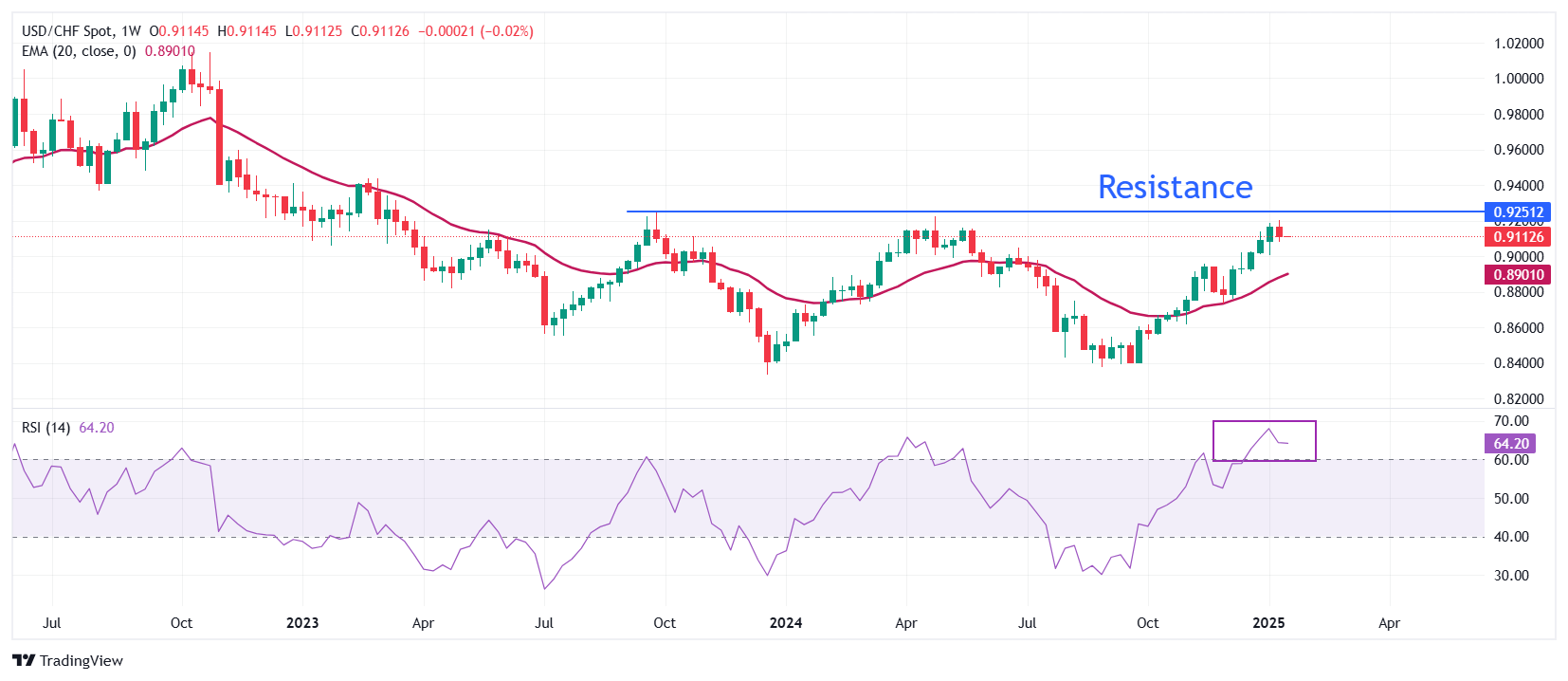USD/CHF Price Forecast: Ticks lower despite upbeat US Dollar
- USD/CHF edges lower even though the US Dollar holds ground ahead of US Trump’s inauguration ceremony.
- Traders have raised Fed dovish bets after surprisingly soft annual US CPI reading for December.
- The SNB is expected to continue reducing interest rates to avoid risks of inflation remaining lower.
The USD/CHF pair edges lower to near the round-level support of 0.9100 in Friday’s European session. The Swiss Franc pair falls marginally as the Swiss Franc (CHF) performs strongly against its major peers even though market participants expect the Swiss National Bank (SNB) to continue easing the monetary policy further.
Swiss Franc PRICE Today
The table below shows the percentage change of Swiss Franc (CHF) against listed major currencies today. Swiss Franc was the strongest against the Japanese Yen.
| USD | EUR | GBP | JPY | CAD | AUD | NZD | CHF | |
|---|---|---|---|---|---|---|---|---|
| USD | 0.03% | 0.29% | 0.36% | 0.11% | 0.10% | 0.15% | 0.00% | |
| EUR | -0.03% | 0.26% | 0.34% | 0.09% | 0.07% | 0.14% | -0.02% | |
| GBP | -0.29% | -0.26% | 0.04% | -0.18% | -0.19% | -0.13% | -0.29% | |
| JPY | -0.36% | -0.34% | -0.04% | -0.22% | -0.24% | -0.19% | -0.34% | |
| CAD | -0.11% | -0.09% | 0.18% | 0.22% | -0.02% | 0.05% | -0.11% | |
| AUD | -0.10% | -0.07% | 0.19% | 0.24% | 0.02% | 0.06% | -0.09% | |
| NZD | -0.15% | -0.14% | 0.13% | 0.19% | -0.05% | -0.06% | -0.15% | |
| CHF | -0.01% | 0.02% | 0.29% | 0.34% | 0.11% | 0.09% | 0.15% |
The heat map shows percentage changes of major currencies against each other. The base currency is picked from the left column, while the quote currency is picked from the top row. For example, if you pick the Swiss Franc from the left column and move along the horizontal line to the US Dollar, the percentage change displayed in the box will represent CHF (base)/USD (quote).
Growing risks of Swiss inflation undershooting the SNB’s target have accelerated, resulting in the need for more interest rate cuts. The SNB has already reduced its key borrowing rates to 0.5%.
Meanwhile, the US Dollar (USD) gains as investors are cautious ahead of President-elect Donald Trump’s swearing-in ceremony on Monday. Investors expect Trump to announce economic policies, such as higher tariffs and lower taxes, soon after returning to the White House. The US Dollar Index (DXY), which tracks the Greenback’s value against six major currencies, ticks higher to near 109.15.
The Greenback remains firm even though an unexpected deceleration in the core Consumer Price Index (CPI) data for December has forced traders to raise Federal Reserve (Fed) dovish bets.
USD/CHF is on track to revisit its 15-month high, around 0.9200. The outlook of the Swiss Franc pair remains firm as the 20-week Exponential Moving Average (EMA) near 0.8900 is sloping higher.
The 14-week Relative Strength Index (RSI) oscillates in the bullish range of 60.00-80.00, suggesting a strong upside momentum.
For a fresh upside toward the round-level resistance of 0.9300 and the 16 March 2023 high of 0.9342, the asset needs to break decisively above the October 2023 high of 0.9244.
On the flip side, a downside move below the psychological support of 0.9000 would drag the asset towards the November 22 high of 0.8958, followed by the December 16 low of 0.8900.
USD/CHF weekly chart
US Dollar FAQs
The US Dollar (USD) is the official currency of the United States of America, and the ‘de facto’ currency of a significant number of other countries where it is found in circulation alongside local notes. It is the most heavily traded currency in the world, accounting for over 88% of all global foreign exchange turnover, or an average of $6.6 trillion in transactions per day, according to data from 2022. Following the second world war, the USD took over from the British Pound as the world’s reserve currency. For most of its history, the US Dollar was backed by Gold, until the Bretton Woods Agreement in 1971 when the Gold Standard went away.
The most important single factor impacting on the value of the US Dollar is monetary policy, which is shaped by the Federal Reserve (Fed). The Fed has two mandates: to achieve price stability (control inflation) and foster full employment. Its primary tool to achieve these two goals is by adjusting interest rates. When prices are rising too quickly and inflation is above the Fed’s 2% target, the Fed will raise rates, which helps the USD value. When inflation falls below 2% or the Unemployment Rate is too high, the Fed may lower interest rates, which weighs on the Greenback.
In extreme situations, the Federal Reserve can also print more Dollars and enact quantitative easing (QE). QE is the process by which the Fed substantially increases the flow of credit in a stuck financial system. It is a non-standard policy measure used when credit has dried up because banks will not lend to each other (out of the fear of counterparty default). It is a last resort when simply lowering interest rates is unlikely to achieve the necessary result. It was the Fed’s weapon of choice to combat the credit crunch that occurred during the Great Financial Crisis in 2008. It involves the Fed printing more Dollars and using them to buy US government bonds predominantly from financial institutions. QE usually leads to a weaker US Dollar.
Quantitative tightening (QT) is the reverse process whereby the Federal Reserve stops buying bonds from financial institutions and does not reinvest the principal from the bonds it holds maturing in new purchases. It is usually positive for the US Dollar.

